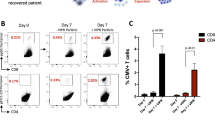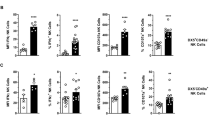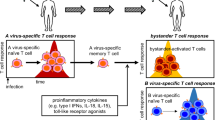Abstract
The virus-specific cytotoxic T lymphocyte (CTL) response is a major obstacle to effective delivery of adenovirus gene therapy. However, its relative role in viral clearance, transgene elimination and hepatotoxicity remains unclear. In this paper, we present an analysis of viral clearance and liver toxicity in relation to the induction of the virus-specific CD8 T-cell response revealed by an MHC class I tetramer. A surprisingly high number of tetramer+ CD8 T cells were found in the liver and lung and reached peak values at days 8 and 10, respectively, post-infection. Nearly 100% of these tetramer+ CD8 T cells expressed high levels of granzyme B and IFNγ. Remarkably, liver viral load and liver enzyme elevation peaked early, at days 2 and 4, respectively, post-infection, before the specific CTL response was detectable. After generation of CTLs, there was only minimal liver damage or further decrease in virus titer. These results indicated that the primary peak response of tetramer+ CTLs does not correlate with the elimination of adenovirus or liver cytotoxic response.
This is a preview of subscription content, access via your institution
Access options
Subscribe to this journal
Receive 12 print issues and online access
$259.00 per year
only $21.58 per issue
Buy this article
- Purchase on Springer Link
- Instant access to full article PDF
Prices may be subject to local taxes which are calculated during checkout






Similar content being viewed by others
References
St George JA . Gene therapy progress and prospects: adenoviral vectors. Gene Therapy 2003; 10: 1135–1141.
Jooss K, Chirmule N . Immunity to adenovirus and adeno-associated viral vectors: implications for gene therapy. Gene Therapy 2003; 10: 955–963.
Hackett NR, Kaminsky SM, Sondhi D, Crystal RG . Antivector and antitransgene host responses in gene therapy. Curr Opin Mol Ther 2000; 2: 376–382.
Bromberg JS, Debruyne LA, Qin L . Interactions between the immune system and gene therapy vectors: bidirectional regulation of response and expression. Adv Immunol 1998; 69: 353–409.
Yang Y, Ertl HC, Wilson JM . MHC class I-restricted cytotoxic T lymphocytes to viral antigens destroy hepatocytes in mice infected with E1-deleted recombinant adenoviruses. Immunity 1994; 1: 433–442.
Yang Y, Su Q, Wilson JM . Role of viral antigens in destructive cellular immune responses to adenovirus vector-transduced cells in mouse lungs. J Virol 1996; 70: 7209–7212.
Harty JT, Tvinnereim AR, White DW . CD8+ T cell effector mechanisms in resistance to infection. Annu Rev Immunol 2000; 18: 275–308.
Quinn D, Zajac A, Hioe C, Frelinger J . Virus-specific, CD8+ major histocompatibility complex class I-restricted cytotoxic T lymphocytes in lymphocytic choriomeningitis virus-infected beta2-microglobulin-deficient mice. J Virol 1997; 71: 8392–8396.
Worgall S, Wolff G, Falck-Pedersen E, Crystal RG . Innate immune mechanisms dominate elimination of adenoviral vectors following in vivo administration. Hum Gene Ther 1997; 8: 37–44.
Schiedner G et al. A hemodynamic response to intravenous adenovirus vector particles is caused by systemic Kupffer cell-mediated activation of endothelial cells. Hum Gene Ther 2003; 14: 1631–1641.
Muruve DA et al. Helper-dependent adenovirus vectors elicit intact innate but attenuated adaptive host immune responses in vivo. J Virol 2004; 78: 5966–5972.
Shayakhmetov DM, Li Z-Y, Ni S, Lieber A . Analysis of adenovirus sequestration in the liver, transduction of hepatic cells, and innate toxicity after injection of fiber-modified vectors. J Virol 2004; 78: 5368–5381.
Zhang HG et al. Hepatic DR5 induces apoptosis and limits adenovirus gene therapy product expression in the liver. J Virol 2002; 76: 5692–5700.
Kim M, Kim K . Diversity and complexity of CD8+ T cell responses against a single epitope of adenovirus E1B. Virology 2002; 295: 238–249.
Toes RE et al. Efficient tumor eradication by adoptively transferred cytotoxic T-cell clones in allogeneic hosts. Int J Cancer 1996; 66: 686–691.
Toes RE et al. An adenovirus type 5 early region 1B-encoded CTL epitope-mediating tumor eradication by CTL clones is down-modulated by an activated ras oncogene. J Immunol 1995; 154: 3396–3405.
Kaech SM et al. Selective expression of the interleukin 7 receptor identifies effector CD8 T cells that give rise to long-lived memory cells. Nat Immunol 2003; 4: 1191–1198.
Yang Y et al. Cellular immunity to viral antigens limits E1-deleted adenoviruses for gene therapy. Proc Natl Acad Sci USA 1994; 91: 4407–4411.
Liu ZX, Govindarajan S, Okamoto S, Dennert G . Fas- and tumor necrosis factor receptor 1-dependent but not perforin-dependent pathways cause injury in livers infected with an adenovirus construct in mice. Hepatology 2000; 31: 665–673.
Liu Z-X, Govindarajan S, Okamoto S, Dennert G . Fas-mediated apoptosis causes elimination of virus-specific cytotoxic T cells in the virus-infected liver. J Immunol 2001; 166: 3035–3041.
Kafrouni MI, Brown GR, Thiele DL . Virally infected hepatocytes are resistant to perforin-dependent CTL effector mechanisms. J Immunol 2001; 167: 1566–1574.
Kafrouni MI, Brown GR, Thiele DL . The role of TNF–TNFR2 interactions in generation of CTL responses and clearance of hepatic adenovirus infection. J Leukoc Biol 2003; 74: 564–571.
Altman JD et al. Phenotypic analysis of antigen-specific T lymphocytes. Science 1996; 274: 94–96.
Serbina N, Pamer EG . Quantitative studies of CD8+ T-cell responses during microbial infection. Curr Opin Immunol 2003; 15: 436–442.
Goldrath AW et al. Cytokine Requirements for acute and basal homeostatic proliferation of naive and memory CD8+ T cells. J Exp Med 2002; 195: 1515–1522.
Schluns KS, Kieper WC, Jameson SC, Lefrancois L . Interleukin-7 mediates the homeostasis of naive and memory CD8 T cells in vivo. Nat Immunol 2000; 1: 426–432.
Peschon JJ et al. Early lymphocyte expansion is severely impaired in interleukin 7 receptor-deficient mice. J Exp Med 1994; 180: 1955–1960.
Wherry EJ et al. Lineage relationship and protective immunity of memory CD8 T cell subsets. Nat Immunol 2003; 4: 225–234.
Lusky M et al. In vitro and in vivo biology of recombinant adenovirus vectors with E1, E1/E2A, or E1/E4 deleted. J Virol 1998; 72: 2022–2032.
Worgall S et al. Role of alveolar macrophages in rapid elimination of adenovirus vectors administered to the epithelial surface of the respiratory tract. Hum Gene Ther 1997; 8: 1675–1684.
Wadsworth S, Zhou H, Smith A, Kaplan J . Adenovirus vector-infected cells can escape adenovirus antigen-specific cytotoxic T-lymphocyte killing in vivo. J Virol 1997; 71: 5189–5196.
Belz GT, Altman JD, Doherty PC . Characteristics of virus-specific CD8+ T cells in the liver during the control and resolution phases of influenza pneumonia. Proc Natl Acad Sci USA 1998; 95: 13812–13817.
Wong P, Pamer EG . Feedback regulation of pathogen-specific T cell priming. Immunity 2003; 18: 499–511.
Matsuki Y et al. Soluble Fas gene therapy protects against Fas-mediated apoptosis of hepatocytes but not the lethal effects of Fas-induced TNF-alpha production by Kupffer cells. Cell Death Differ 2002; 9: 626–635.
Gross D-A et al. CD4+CD25+ regulatory T cells inhibit immune-mediated transgene rejection. Blood 2003; 102: 4326–4328.
Sung RS, Qin L, Bromberg JS . TNF(alpha) and IFN(gamma) induced by innate anti-adenoviral immune responses inhibit adenovirus-mediated transgene expression. Mol Therapy 2001; 3: 757–767.
Mueller SN et al. Rapid cytotoxic T lymphocyte activation occurs in the draining lymph nodes after cutaneous Herpes Simplex Virus infection as a result of early antigen presentation and not the presence of virus. J Exp Med 2002; 195: 651–656.
Kagi D et al. Cytotoxicity mediated by T cells and natural killer cells is greatly impaired in perforin-deficient mice. Nature 1994; 369: 31–37.
Zajac AJ, Dye JM, Quinn DG . Control of lymphocytic choriomeningitis virus infection in granzyme B deficient mice. Virology 2003; 305: 1–9.
Khakoo SI et al. HLA and NK cell inhibitory receptor genes in resolving hepatitis C virus infection. Science 2004; 305: 872–874.
Vogels R et al. Replication-deficient human adenovirus type 35 vectors for gene transfer and vaccination: efficient human cell infection and bypass of preexisting adenovirus immunity. J Virol 2003; 77: 8263–8271.
SYFPEITHI http://syfpeithi.bmi-heidelberg.com/.
Olive M et al. The adenovirus capsid protein hexon contains a highly conserved human CD4+ T-cell epitope. Hum Gene Ther 2002; 13: 1167–1178.
Zhang HG et al. Induction of specific T-cell tolerance by adenovirus-transfected, Fas ligand-producing antigen presenting cells. Nat Biotechnol 1998; 16: 1045–1049.
Fuller MJ, Zajac AJ . Ablation of CD8 and CD4 T cell responses by high viral loads. J Immunol 2003; 170: 477–486.
Khanolkar A, Fuller MJ, Zajac AJ . CD4 T cell-dependent CD8 T cell maturation. J Immunol 2004; 172: 2834–2844.
Acknowledgements
We thank Dr Fiona Hunter for reviewing the manuscript, Dr Rafi Ahmed for providing critical suggestions, and Carol Humber for excellent secretarial work. This work was supported in part by National Institutes of Health Grants RO1-AI-42900 (to JD Mountz) and RO1-CA-86881 (to DT Curiel), and by a VA Career Development Award and Merit Review Award (to JD Mountz).
Author information
Authors and Affiliations
Rights and permissions
About this article
Cite this article
Chen, J., Zajac, A., McPherson, S. et al. Primary adenovirus-specific cytotoxic T lymphocyte response occurs after viral clearance and liver enzyme elevation. Gene Ther 12, 1079–1088 (2005). https://doi.org/10.1038/sj.gt.3302494
Received:
Accepted:
Published:
Issue Date:
DOI: https://doi.org/10.1038/sj.gt.3302494
Keywords
This article is cited by
-
Understanding and addressing barriers to successful adenovirus-based virotherapy for ovarian cancer
Cancer Gene Therapy (2021)
-
Ad3-hTERT-E1A, a Fully Serotype 3 Oncolytic Adenovirus, in Patients With Chemotherapy Refractory Cancer
Molecular Therapy (2012)
-
Enhancement of Cytotoxic T-lymphocyte Response in Aged Mice by a Novel Treatment with Recombinant AdIL-12 and Wild-type Adenovirus in Rapid Succession
Molecular Therapy (2008)
-
Oncolytic adenoviruses – selective retargeting to tumor cells
Oncogene (2005)



